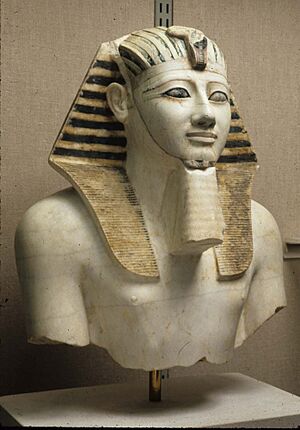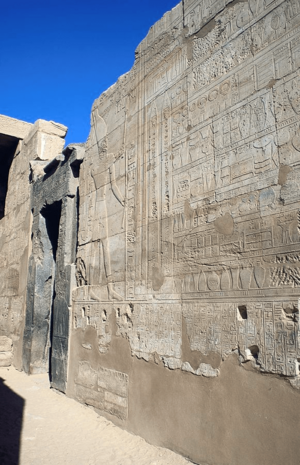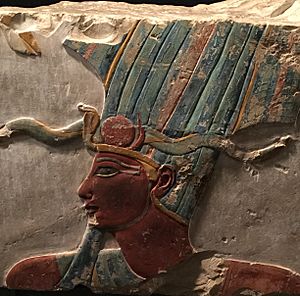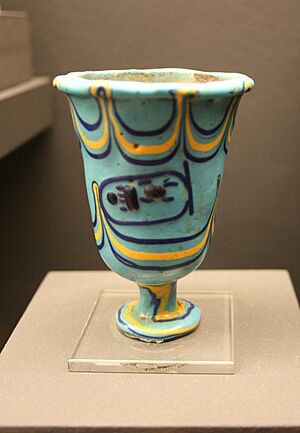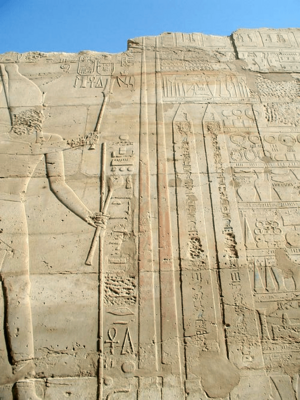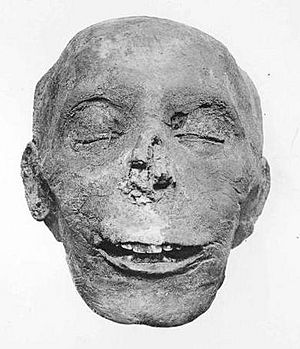Thutmose III facts for kids
Quick facts for kids Thutmose III |
|
|---|---|
| Tuthmosis III, "Manahpi(r)ya" in the Amarna letters | |
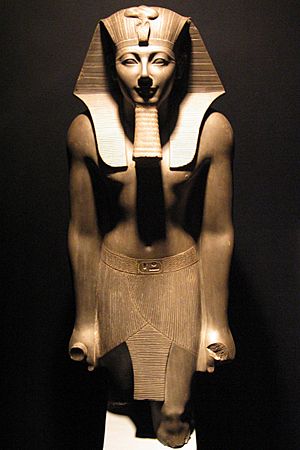
Thutmosis III statue in Luxor Museum
|
|
| Pharaoh | |
| Reign | 1479 – 1425 BC (Eighteenth Dynasty) |
| Predecessor | Hatshepsut |
| Successor | Amenhotep II |
| Consort | Satiah, Hatshepsut-Meryetre, Nebtu, Menwi, Merti, Menhet, Nebsemi |
| Children | Amenemhat, Amenhotep II, Beketamun, Iset, Menkheperre, Meryetamun, Meryetamun, Nebetiunet, Nefertiri, Siamun |
| Father | Thutmose II |
| Mother | Iset |
| Born | 1481 BC |
| Died | 1425 BC (aged 56) |
| Burial | KV34 |
| Monuments | Cleopatra's Needle Obelisk of Theodosius |
Thutmose III (also spelled Tuthmosis or Thothmes), sometimes called Thutmose the Great, was a powerful pharaoh of ancient Egypt. He was the sixth ruler of the Eighteenth Dynasty. Thutmose III ruled Egypt for nearly 54 years, from 1479 BC to 1425 BC. He became pharaoh when he was only two years old and ruled until he died at age 56.
For the first 22 years of his rule, he shared power with his stepmother and aunt, Hatshepsut. She was also a pharaoh. Even though he was shown first on old monuments, both Thutmose III and Hatshepsut had royal titles and symbols. Thutmose was even the leader of Hatshepsut's armies. Towards the end of his life, he made his son, Amenhotep II, a junior co-ruler. Thutmose III became one of the most powerful pharaohs of his time.
After Hatshepsut passed away, Thutmose III became the sole ruler. He built the largest empire Egypt had ever seen. He led at least 17 military campaigns, conquering lands from Syria in the north to Upper Nubia in the south.
When Thutmose III died, he was buried in the Valley of the Kings. This was a special burial place for kings in Egypt. He is remembered as one of the greatest and most famous rulers of the New Kingdom period. This time is often seen as the peak of ancient Egyptian power.
Contents
Understanding Thutmose's Name
Thutmose's main names tell us a lot about him. His first name, Menkheperre, means "Lasting is the manifestation of Ra". Ra was the sun god. His second name, Thutmose or Tuthmosis, means "Born of Thoth". Thoth was the god of wisdom and writing.
Thutmose's Royal Family
Thutmose III was the son of Thutmose II. His mother was a secondary wife named Iset. His father's main wife was Queen Hatshepsut. Hatshepsut's daughter, Neferure, was Thutmose III's half-sister.
When Thutmose II died, Thutmose III was too young to rule alone. Hatshepsut became his regent, meaning she ruled for him. Soon, she became his co-ruler and then declared herself pharaoh. However, she never took away Thutmose III's right to be king. Hatshepsut's rule was very successful, with many great achievements. When Thutmose III grew up and showed he was capable, she made him the head of her armies.
Some historians think Thutmose III might have married his half-sister, Neferure. But there is no clear proof. It's also thought that Neferure or his Great Royal Wife Satiah might have been the mother of his first son, Amenemhat. Sadly, Amenemhat died before his father.
Thutmose III had other wives too. We know he had at least three foreign wives: Menwi, Merti, and Menhet. They were buried together. Another wife, Nebtu, is known from his tomb. After Satiah died, Merytre-Hatshepsut became the Great Royal Wife. She was the mother of several of his children, including the future king Amenhotep II.
How Long Thutmose Ruled
Thutmose III ruled from 1479 BC to 1425 BC. We know the exact length of his reign thanks to records found in the tomb of a military leader named Amenemheb-Mahu. These records say Thutmose III died in his 54th year as ruler. He ruled for "53 years, 10 months, and 26 days." This means he died just over a month before his 54th year officially ended.
Thutmose's Military Victories
Historians often call Thutmose III a military genius. He led at least 16 campaigns in 20 years. He was a king who actively expanded Egypt's borders. Some even call him "the Napoleon of Egypt." He is said to have captured 350 cities and conquered much of the Near East, from the Euphrates River to Nubia. He was the first pharaoh since Thutmose I to cross the Euphrates.
His campaign records were carved onto the walls of the temple of Amun at Karnak. He is seen as one of Egypt's greatest warrior pharaohs. He turned Egypt into a powerful empire. In most of his campaigns, he defeated his enemies city by city until they surrendered.
We know a lot about Thutmose the warrior because of his royal scribe and army commander, Thanuny. Thanuny wrote about his conquests. Thutmose III was able to conquer so much land partly because of new military technology. The Hyksos people had brought advanced weapons, like horse-drawn chariots, to Egypt. The Egyptians learned to use these weapons when they drove the Hyksos out. Thutmose III's army also carried boats over land, which helped them cross rivers easily.
First Major Campaign
When Hatshepsut died, the king of Kadesh led his army to Megiddo. Thutmose III quickly gathered his army and left Egypt. He marched his troops to Yehem, a small city near Megiddo. The Battle of Megiddo was probably the biggest battle of Thutmose's 17 campaigns.
A mountain ridge stood between Thutmose and Megiddo. His war council suggested safer routes around the mountain. But Thutmose, showing great courage, chose a dangerous path through the Aruna mountain pass. He claimed it was only wide enough for soldiers to pass "horse after horse and man after man."
This was a smart move. When his army came out of the pass, they were right behind the enemy forces and between them and Megiddo. For some reason, the enemy did not attack. Thutmose's army then defeated them. The battle likely happened on May 9, 1457 BC. After winning, his troops stopped to take spoils, allowing the enemy to escape into Megiddo. Thutmose had to besiege the city, but he finally conquered it after seven or eight months.
This campaign changed the ancient Near East. By taking Megiddo, Thutmose controlled northern Canaan. Princes from Syria had to send tribute and their sons as hostages to Egypt. Kings from Assyria, Babylon, and the Hittites also sent gifts to Thutmose. He called these "tribute" in his records. Only Mitanni did not send gifts, and they would face Egypt's next campaigns.
Campaigns in Syria
Thutmose III's later campaigns were often tours of Syria and Canaan to collect tribute. His third campaign was not recorded in detail, but a survey of the animals and plants he found in Canaan was drawn on the walls of a special room at Karnak.
His fifth, sixth, and seventh campaigns focused on the Phoenician cities in Syria and Kadesh. In his 29th year, he began his fifth campaign. He took a city that had been protected by Tunip. Then he moved inland and took the city and land around Ardata. He pillaged the town and burned the wheat fields. Unlike earlier raids, Thutmose III placed soldiers in the area called Djahy (southern Syria). This allowed him to send supplies and troops between Syria and Egypt.
In his 30th year, Thutmose's sixth campaign might have started with troops sailing directly to Byblos, avoiding Canaan. After arriving in Syria, they went north, raiding Kadesh's lands. Thutmose then took Simyra and stopped a rebellion in Ardata. To prevent more rebellions, Thutmose began taking important family members from Syrian cities as hostages to Egypt. This made the cities more loyal to him. Syria rebelled again in Thutmose's 31st year. He returned for his seventh campaign, took the port city of Ullaza and other smaller Phoenician ports. He stored all the extra grain from Syria in these ports. This grain was used to support the Egyptian army and officials ruling Syria. This made the Syrian cities very poor, so they couldn't afford to rebel.
Attacking Mitanni
After controlling the Syrian cities, Thutmose III's next target was Mitanni. To reach Mitanni, he had to cross the Euphrates River. He sailed to Byblos and built boats there. He then carried these boats over land during what seemed like another tour of Syria. He raided and pillaged as he moved north through lands he already controlled. He continued north through Aleppo and Carchemish and quickly crossed the Euphrates using his boats. The Mitannian king was completely surprised.
It seems Mitanni was not expecting an invasion and had no army ready. Thutmose III freely moved from city to city, pillaging them. Nobles hid in caves. Thutmose put up a second stele (a stone slab with carvings) to remember his crossing of the Euphrates. It was next to one his grandfather, Thutmose I, had put up earlier. A local army was formed to fight, but it did not do well. Thutmose III then returned to Syria. He collected tribute from foreign powers and returned to Egypt victorious.
Later Syrian Tours
Thutmose III returned to Syria for his ninth campaign in his 34th year. This was likely a small raid on Nukhashshe, a region of semi-nomadic people. Records from his 10th campaign show more fighting. In Thutmose's 35th year, the king of Mitanni raised a large army and fought the Egyptians near Aleppo. Thutmose claimed a total victory, but the small amount of loot taken suggests it might have been a stalemate. However, he did receive tribute from the Hittites after this, which suggests he won.
Details about his 11th and 12th campaigns are not fully known. His 13th campaign was a small one back in Nukhashshe. His 14th campaign, in his 39th year, was against the Shasu, who were nomads. The exact location is unknown.
His final Asian campaign is better documented. Before Thutmose's 42nd year, Mitanni seemed to be causing revolts in Syrian cities. Thutmose moved his troops along the coast and stopped rebellions in the Arka plain. He then moved to Tunip. After taking Tunip, he focused on Kadesh again. He fought and destroyed three nearby Mitannian garrisons and returned to Egypt victorious. This victory was not complete, as he didn't take Kadesh, and Tunip likely didn't stay loyal for long. But this win was important, as later tribute lists included Adana, a city in Cilicia.
Nubian Campaign
Thutmose's last campaign was in his 50th year as pharaoh. He attacked Nubia, going as far as the fourth cataract of the Nile River. No Egyptian king had gone so far with an army before.
Building Great Monuments
Thutmose III was a great builder. He ordered the construction of over 50 temples, though some are now lost. He also had many tombs built for nobles, which were made with amazing skill. His reign also saw big changes in the style of sculptures, paintings, and reliefs. Many of these changes started during Hatshepsut's rule.
Artistic Progress
Thutmose's builders and artists continued the traditional styles of earlier kings. But they also made new developments. After his 42nd year, he started being shown wearing the red crown of Lower Egypt and a special kilt, which was new. In architecture, his use of pillars was also unique. He built Egypt's only known set of "heraldic pillars," which were two large columns standing alone. His jubilee hall was also revolutionary, possibly the earliest building designed like a basilica. Thutmose's artists became very skilled in painting. Tombs from his time were the first to be fully painted instead of having carved and painted reliefs. Also, his artists learned to make glass drinking vessels using a special method.
Karnak Temple Projects
Thutmose focused much of his building efforts on Karnak. In the main temple, he rebuilt the great hall of his grandfather Thutmose I. He also built Pylon VI and a shrine for the boat of Amun. East of the main sanctuary, he built a jubilee hall to celebrate his Sed festival (a celebration of a king's long rule). This hall was built in the basilica style, with rows of pillars supporting a high central ceiling. Two smaller rooms in this temple showed reliefs of the plants and animals he found in Canaan during his third campaign.
East of the main temple, he built another temple for Aten, the sun disk god. Here, Thutmose planned to put up his tekhen waty, or "unique obelisk." This obelisk was meant to stand alone and was the tallest ever carved. However, it was not put up until Thutmose IV did it 35 years later. It was later moved to Rome and is now known as the Lateran Obelisk.
Another obelisk from Thutmose III's Karnak temple was moved to Constantinople (modern-day Istanbul) in 390 AD. It is now called the Obelisk of Theodosius. So, two of Thutmose III's obelisks from Karnak now stand in Rome and Istanbul.
Thutmose also built south of the main temple. He built the seventh pylon, which was covered with scenes of defeated enemies. He placed royal statues and two more obelisks there. The western obelisk was moved to Constantinople. Further south, he built Pylon VIII, which Hatshepsut had started. He also dug a large sacred lake and placed another alabaster boat shrine near it. He had artists draw his large collections of plants and animals in the Botanical garden of Thutmosis III.
Hatshepsut's Monuments
For many years, historians thought that Thutmose III damaged Hatshepsut's monuments because she had "taken" the throne from him. They believed he was angry that she ruled for the first two decades of his reign. However, this idea has changed. Why would Hatshepsut let an angry heir lead her armies, which she did? Also, Hatshepsut's monuments were not damaged until at least 25 years after her death, when Thutmose III was quite old. At that time, he was sharing power with his son, Amenhotep II. Amenhotep II is known to have tried to claim Hatshepsut's works as his own. Also, Thutmose III's own temple was built right next to Hatshepsut's. This would be unlikely if he held a grudge against her.
After Hatshepsut died, many of her monuments were damaged or destroyed. This included her famous temple at Deir el-Bahri. Early scholars thought this was Thutmose III trying to erase her memory. But recent research shows that this damage only started around year 46 or 47 of Thutmose's reign. Also, Hatshepsut was not the only one whose monuments were damaged. Her chief official, Senenmut, who was close to her rule, also had his monuments defaced. All this makes the idea of Thutmose III acting out of revenge less likely.
Today, historians believe the destruction of Hatshepsut's memory was done to make sure Thutmose III's son, Amenhotep II, would become king smoothly. It prevented any of Hatshepsut's living relatives from claiming the throne. This action might have happened after powerful religious and government officials who served both Hatshepsut and Thutmose III had died. Later, Amenhotep II even claimed that he had built the things he damaged.
Death and Burial
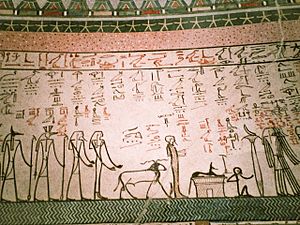
Thutmose III's tomb (KV34) was found in 1898 in the Valley of the Kings. It has a typical design for 18th Dynasty tombs, with a sharp turn before the burial chamber.
A full version of the Amduat, an important ancient Egyptian text about the afterlife, is in the tomb's entrance room. This was the first tomb where Egyptologists found the complete text. The burial chamber is oval-shaped and its ceiling is decorated with stars. In the middle is a large red stone sarcophagus shaped like a cartouche (an oval with a king's name). The walls show Thutmose III helping the gods defeat Apep, the serpent of chaos. This was meant to help ensure the sun's daily rebirth and the pharaoh's own resurrection.
Thutmose III died in his 54th year of rule, after ruling for "53 years, 10 months and 26 days." When you take out the time he shared power with Hatshepsut and Amenhotep II, he ruled alone for just over 30 years.
Thutmose's Mummy
Thutmose III's mummy was found in 1881 in a secret hiding place called the Deir el-Bahri Cache. It was found near Hatshepsut's temple. His mummy was buried with other famous pharaohs.
His mummy was first unwrapped in 1881. It had been badly damaged by tomb robbers long ago. The wooden coffin that held his body was his original one, but any gold or decorations had been cut off.
In 1980, scientists examined Thutmose III's mummy using X-rays. They found that the royal mummies of the 18th Dynasty looked similar to people from Nubia at that time.
His mummy was about 5 feet 3.58 inches tall, but his feet were missing, so he was likely taller. Thutmose III's mummy was kept in the Egyptian Museum until April 2021. Then, it was moved to the National Museum of Egyptian Civilization with other royal mummies in a special event called the Pharaohs' Golden Parade.
See also
 In Spanish: Tutmosis III para niños
In Spanish: Tutmosis III para niños
- Cleopatra's Needles
- History of ancient Egypt
- Eighteenth Dynasty of Egypt family tree



